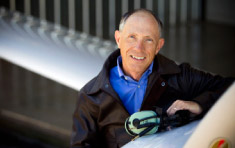
A high overcast in the western sky was rapidly morphing into the angry gray of an approaching cold front. Here in the Midwest they build them long, tall, and mean. My fuel stop in Mt. Vernon, Illinois, was abbreviated because of the weather 100 miles west. Destination: Wichita. Go north, south, or stay put?
The year: 1979. My ride: a Cessna Turbo 210. It would be more than 10 years before the first weather datalink displays appeared in general aviation cockpits. This particular aircraft, which belonged to the Cessna Aircraft Co.—my employer at the time—didn’t even have the little digital radar pod that graced many of our demonstrators’ right wings. Bad luck to have drawn a barefoot airplane on such an active weather day!
But much farther to the east—at about the same time at NASA’s Langley Research Center in Virginia—the Storms Hazard Program was just getting under way. The objective was to evaluate lightning strikes in aircraft with special emphasis on protecting composite components and airframes to understand why an airplane might get blown out of the sky. A hell-for-stout F–106 was used for strike bait. The NASA crew was going boldly where few had gone before—intentionally.
Research abounds with useful serendipitous discoveries. To get lots of lightning juice the jet needed to find boomers quickly. Ground-based radar was moderately helpful but there had to be a better, faster way. The NASA team soon figured out that one datalink picture direct to the cockpit was worth a thousand vectors. That’s when the NASA program manager, Norm Crabill, AOPA member, three-decade employee of NACA/NASA, and private pilot, started asking, “If we can datalink precipitation pictures up to an F–106, why not a general aviation aircraft?” It took from 1982—when the first uplinked radar pix were sent to the jet—until 1988 when Crabill wrote the paper, “Cockpit Weather Research, Development, and Applications—Survey and Recommendations” that a new direction emerged.
By 1989 Crabill had retired from NASA and was working as a contractor. With Ernie Dash and Scott Shipley, the three managed to finagle, persuade, and cajole scarce research dollars into one of the most useful and revolutionary technologies that GA has seen in recent times. The patent application stated the obvious: pilots needed current weather en route in both text and pictorial form because weather is dynamic and, in many cases, hazardous. With more accurate and timely weather information, pilots could make better decisions and more flights could be completed safely.
What we get in today’s cockpit is pretty intuitive, but the system behind it was not. This quote from the patent application may give you some appreciation for the complexity and genius that went into the marvelous equipment we now take for granted: “The weather information is edited and packaged into compressed coded digital data blocks, usually of five-minute lengths, and transmitted as digital signals to the ground transmitter of a satellite communications system. This transmission is via an uplink data stream and, typically, at 6 GHz. The satellite communication system then provides a direct broadcast (typically at 1.6 GHz) of the suitably coded weather information to all aircraft within its coverage area, either in the air, or on the surface of the Earth. The rebroadcast data blocks may be picked up by an antenna on any aircraft flying, or on the ground, within the coverage area. The received data blocks are expanded and decoded, if needed, by a flight processor on-board the aircraft into several types of graphic depictions for display on a small screen and using a standard map with shapes and colors to define the various pilot-oriented display classifications. All the weather information needed for flight operations within the satellite coverage area is transmitted from the satellite to all aircraft operating within that coverage area.” Whew!
Back to 1979: I left the Indy Center IFR frequency for Flight Watch. The party line was humming and it was five solid minutes before I could get a word in edgewise. That’s a long time when you’re moving three miles a minute toward weather that’s moving quickly toward you. The specialist suggested a hole 100 miles south as the best way to go. Back on Center frequency, it was hopping, too, with everyone shucking and jiving to get around the cells. I had one ear listening to Flight Watch hoping to gather what little extra info might be had when they called, asking if I was still there. Why, yes. OK, the southern hole had closed up and north over St. Louis looked much better. I asked Indy for a course reversal and worked through the line quite a bit farther north, but not without some trepidation because it looked pretty dark. No rain, mostly light turbulence, and one good thump. How much different would it have been today with datalink?
Bruce Landsberg has logged more than 6,000 hours as an airline transport pilot.



